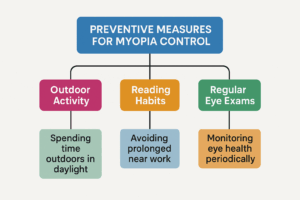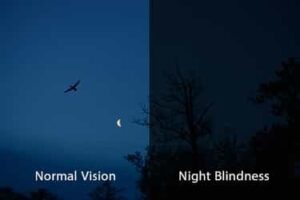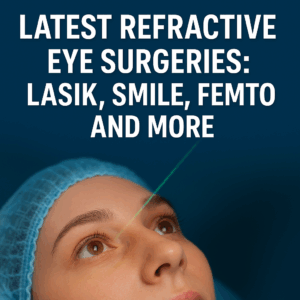
Anushka Super Speciality Eye Hospital
Call: 90044 44422 / 99213 44422 | Timings : 8.30 a.m to 5.30 p.m (Mon-Sat) | Add: Shri Swami Samarth Soc, Kaneri Dhamankar Naka, Bhiwandi




Accredited for Quality Care
Myopia Control: Understanding, Preventing, and Managing Nearsightedness
anushka
15 July 2025
Myopia, commonly known as near-sightedness, is one of the most prevalent refractive errors globally. With the increasing use of digital devices, reduced outdoor activity, and changing lifestyle patterns, myopia has become a growing public health concern. This blog will provide an in-depth understanding of myopia, its types, prevalence, and scientifically proven strategies for myopia control.
What is Myopia?
Myopia is a vision condition where distant objects appear blurry while close objects are seen clearly. It occurs when the eyeball is too long or the cornea is too curved, causing light to focus in front of the retina instead of directly on it.
Typical symptoms include:
- Blurred distance vision
- Squinting to see clearly
- Eye strain
- Headaches
Myopia usually develops in childhood and can progress rapidly if not properly managed.
Types of Myopia
- Simple Myopia
- The most common form
- Generally occurs during school-age and stabilizes in early adulthood
- Can range from mild to moderate in severity
- High Myopia
- A severe form, typically above -6.00 diopters
- Can lead to increased risk of retinal detachment, glaucoma, and macular degeneration
- Pathological (Degenerative) Myopia
- A progressive and often hereditary condition
- Associated with structural changes in the eye and potential vision loss
Understanding the type of myopia is crucial for determining the appropriate myopia control strategies.
Prevalence of Myopia
According to recent studies:
- Nearly 30% of the global population is myopic
- By 2050, it is estimated that half of the world’s population will be affected
- In India, myopia prevalence among school-aged children is rising rapidly, with urban areas witnessing higher rates
The increasing numbers highlight the urgent need for awareness and preventive strategies.

Measures to Prevent the Progression of Myopia
Controlling myopia progression is essential to reduce the risk of future eye complications. Here are the most effective methods backed by clinical research:
1. Increased Outdoor Activity
Spending more time outdoors—at least 2 hours a day—has been shown to slow myopia onset and progression in children. Natural sunlight helps regulate eye growth, and looking at distant objects improves ocular health.
Tip: Encourage outdoor play, sports, or walks in natural light. Reduce screen time and indoor confinement.
2. Limit Near Work and Screen Time
Prolonged near work, such as reading, writing, and digital screen use, is linked with faster myopia progression. Maintaining proper posture and taking regular breaks can help.
Tip: Follow the 20-20-20 rule—every 20 minutes, look at something 20 feet away for at least 20 seconds.
3. Use of Atropine Eye Drops
Low-dose atropine (typically 0.01%) has shown promising results in slowing myopia progression in children. It works by relaxing the eye’s focusing mechanism.
Note: Should be used under ophthalmologist supervision due to potential side effects like light sensitivity or dry eyes.
4. Orthokeratology (Ortho-K)
Ortho-K lenses are specially designed rigid gas-permeable contact lenses worn overnight. They temporarily reshape the cornea and control eye elongation.
Benefit: Drug-free and reversible. Effective in moderate myopia and ideal for active children.
5. Multifocal or Myopia Control Spectacles
Specialized spectacle lenses (like DIMS lenses) are designed to reduce peripheral hyperopic defocus, which contributes to myopia progression.
Tip: These lenses are now widely available and can be prescribed after a comprehensive eye examination.
6. Multifocal Soft Contact Lenses
These lenses have different power zones to help focus light correctly on the retina and slow down eye elongation.
Note: Regular follow-up with an optometrist is essential to monitor fit and effectiveness.
Frequently Asked Questions (FAQs)
1. What age does myopia usually start?
Most cases of myopia begin between ages 6 and 14, although it can develop earlier or later. Early detection is key to effective control.
2. Can myopia be cured?
Myopia cannot be cured, but its progression can be effectively slowed down through various management options.
3. Is too much screen time responsible for myopia?
Excessive screen time, especially without breaks, is a contributing factor. It’s essential to balance screen use with outdoor activities.
4. Are myopia control lenses safe for children?
Yes, specially designed myopia control lenses are safe and effective when prescribed and monitored by eye care professionals.
5. How often should my child’s eyes be checked?
Children should undergo a comprehensive eye exam at least once a year, or as recommended by their eye care provider.
Conclusion
Myopia is more than just a need for glasses—it’s a condition that requires proactive monitoring and early intervention. With the right combination of lifestyle changes, optical solutions, and medical guidance, myopia control can significantly reduce the risk of severe eye complications in the future.
If you’re concerned about your child’s vision, consult a certified optometrist or ophthalmologist. Early diagnosis and personalized treatment plans are the best tools for protecting young eyes and ensuring healthy visual development.
Book your child’s eye exam today and take the first step in controlling myopia!
Recent Posts


